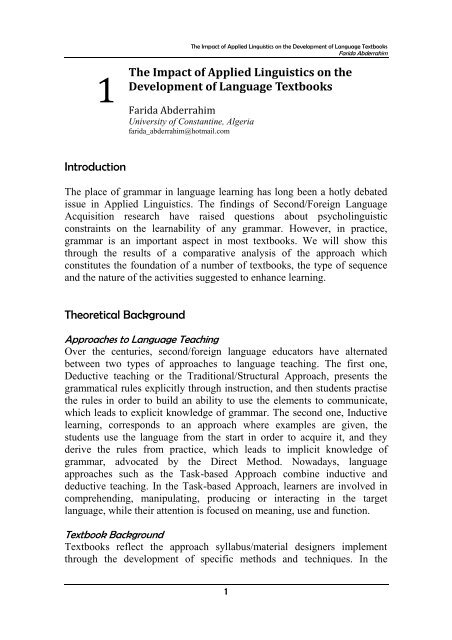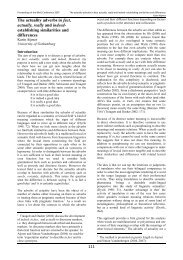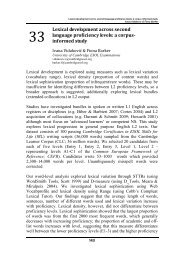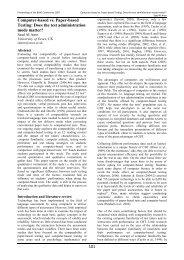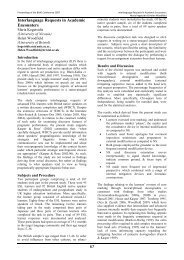Proceedings of the - British Association for Applied Linguistics
Proceedings of the - British Association for Applied Linguistics
Proceedings of the - British Association for Applied Linguistics
Create successful ePaper yourself
Turn your PDF publications into a flip-book with our unique Google optimized e-Paper software.
1<br />
Introduction<br />
The Impact <strong>of</strong> <strong>Applied</strong> <strong>Linguistics</strong> on <strong>the</strong> Development <strong>of</strong> Language Textbooks<br />
Farida Abderrahim<br />
The Impact <strong>of</strong> <strong>Applied</strong> <strong>Linguistics</strong> on <strong>the</strong><br />
Development <strong>of</strong> Language Textbooks<br />
Farida Abderrahim<br />
University <strong>of</strong> Constantine, Algeria<br />
farida_abderrahim@hotmail.com<br />
The place <strong>of</strong> grammar in language learning has long been a hotly debated<br />
issue in <strong>Applied</strong> <strong>Linguistics</strong>. The findings <strong>of</strong> Second/Foreign Language<br />
Acquisition research have raised questions about psycholinguistic<br />
constraints on <strong>the</strong> learnability <strong>of</strong> any grammar. However, in practice,<br />
grammar is an important aspect in most textbooks. We will show this<br />
through <strong>the</strong> results <strong>of</strong> a comparative analysis <strong>of</strong> <strong>the</strong> approach which<br />
constitutes <strong>the</strong> foundation <strong>of</strong> a number <strong>of</strong> textbooks, <strong>the</strong> type <strong>of</strong> sequence<br />
and <strong>the</strong> nature <strong>of</strong> <strong>the</strong> activities suggested to enhance learning.<br />
Theoretical Background<br />
Approaches to Language Teaching<br />
Over <strong>the</strong> centuries, second/<strong>for</strong>eign language educators have alternated<br />
between two types <strong>of</strong> approaches to language teaching. The first one,<br />
Deductive teaching or <strong>the</strong> Traditional/Structural Approach, presents <strong>the</strong><br />
grammatical rules explicitly through instruction, and <strong>the</strong>n students practise<br />
<strong>the</strong> rules in order to build an ability to use <strong>the</strong> elements to communicate,<br />
which leads to explicit knowledge <strong>of</strong> grammar. The second one, Inductive<br />
learning, corresponds to an approach where examples are given, <strong>the</strong><br />
students use <strong>the</strong> language from <strong>the</strong> start in order to acquire it, and <strong>the</strong>y<br />
derive <strong>the</strong> rules from practice, which leads to implicit knowledge <strong>of</strong><br />
grammar, advocated by <strong>the</strong> Direct Method. Nowadays, language<br />
approaches such as <strong>the</strong> Task-based Approach combine inductive and<br />
deductive teaching. In <strong>the</strong> Task-based Approach, learners are involved in<br />
comprehending, manipulating, producing or interacting in <strong>the</strong> target<br />
language, while <strong>the</strong>ir attention is focused on meaning, use and function.<br />
Textbook Background<br />
Textbooks reflect <strong>the</strong> approach syllabus/material designers implement<br />
through <strong>the</strong> development <strong>of</strong> specific methods and techniques. In <strong>the</strong><br />
1


